|
Thursday, Feb. 10
- Breakfast: Apple sticks
- Southwestern chicken tortilla soup
- Philly-style cheese steak
- *Garlic herb roasted pork
- *Mardi Gras jambalaya
- Southwestern turkey wrap
- Assorted sliced pizza
- Marinated grilled chicken Caesar salad
*carb-restricted alternative
Wilson Hall Cafe Menu |
|
Friday, Feb. 11
Valentine's Day dinner
Guest Chef: Joe Walding
Special Time: 6 p.m.
- Moules marinière
- Marinated lamb chops with honey and coriander
- Winter vegetable tagine
- Blueberry and pear frangipane with thyme ice cream
Wednesday, Feb. 16
Lunch
- Chili chicken skewers with cilantro pesto
- Chunky banana sweet-potato mash
-Keylime and tequila pie
Chez Leon Menu
Call x3524 to make your reservation.
|
|
Merle Olson, design coordinator, retires
 |
|
Merle Olson |
Merle Olson is looking forward to retirement and finally spending time with his wife and family. He has been working since he was in high school, first to help his single mother support her five children, and then to support his own family of six.
Olson, senior engineering associate, retired from Fermilab in December after 26 years of service devoted to the FESS engineering group, which was known as Tevatron Construction when Olson joined the laboratory in 1984.
Just as the name of the department has changed, so has the nature of Olson’s work. He began as a mechanical engineer, part of a large, in-house architectural group. “We did everything structural, electrical and mechanical,” he said.
His from-the-ground-up experience became invaluable later on when in-house work was delegated to outside firms. Olson moved into a project coordinator role; a liaison between the laboratory and the contracted architectural and engineering firms. He admitted he felt a bit intimidated at first, but “it worked out great,” he said.
His former boss, Steve Dixon, agreed.
“Over the years, Merle has transitioned from an excellent mechanical engineer to an outstanding design coordinator,” he said.
“He was excellent at coordinating contractors and vendors to ensure projects kept moving on schedule," said Adam Walters, who worked with Olson on the construction of state-of-the art computer rooms, including the ARRA-funded Data Center upgrade projects in the Feynman Computing Center.
“All of the facility operations staff wishes Merle the best in his retirement and he is greatly missed,” said Walters, department head of facility operations in the Computing Division.
Olson and his wife of 40 years, Sharon, are looking forward to taking walks, traveling and spending time with family, which includes six children, 14 grandchildren and five great grandchildren.
-- Rita Hoover
|
|
Korean scientific dignitaries visit Fermilab
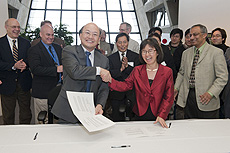 |
On Jan. 24, Dong-Pil Min, the chairman of the Korea Research Council of Fundamental Science & Technology, and Young-Kee Kim, deputy director of Fermilab, signed a Letter of Intent to collaborate on activities such as superconducting radio-frequency technology and accelerator-based sciences, including detectors, computing and data analysis. Photo: Reidar Hahn. |
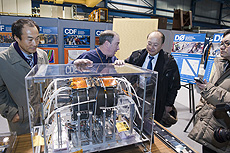 |
The visit included a tour of the 15th floor, CDF, the SRF Accelerator Test Facility and the Dark Energy Camera. CDF co-spokesperson Rob Roser (second from left) explained how the detector works to (from left), Byung-Hoon Oh, director and senior researcher at the Korea Atomic Energy Research Institute, Dong-Pil Min, Chairman of the Korea Research Council of Fundamental Science and Technology, and Whanyung Kim, a reporter from Joong Ang Ilbo. Photo: Reidar Hahn. |
|
Computing to advance new cancer treatment
Feb. 9, 2011
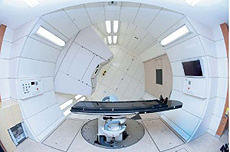 |
| European proton-carbon ion facility in Heidelberg, Germany. Image courtesy GSI, HIT, Siemens. |
Imagine yourself in a tough fight against an entrenched opponent that is small and elusive.
What weapon would you prefer to use: a cannonball or a bullet?
That is the basic concept behind hadrontherapy, a technology that provides more effective, tightly targeted cancer treatment with fewer side effects than conventional radiotherapy. Soon researchers and clinicians will be able to share hadrontherapy-related data via an online 'data hub' supported by grid middleware.
Read more
|
|
Could the Higgs be hiding in graphene?
From Discovery News, Feb. 6, 2011
Pop quiz: what does a sheet of two-dimensional carbon have in common with the early state of the universe? If three Spanish physicists are correct, the way graphene buckles into ripples when compressed could provide some critical insights into the Higgs boson.
Graphene is the two-dimensional version of graphite, the stuff of pencil lead. There was some doubt as to whether this was even possible -- for it to be truly 2D it would have to be a mere atom thick, making it also highly unstable -- but Andre Geim and cohorts at the University of Manchester in the UK succeeded in creating sheets of graphene in 2004, in perhaps the most ingenious use of scotch tape yet devised.
"Scads of physicists have been investigating this new substance further ever since. Geim and Konstantin Novoselov shared the 2010 Nobel Prize in Physics for their graphene research.
Why are scientists so excited about a 2D sheet of carbon? Graphene has quantum superpowers! Much has been made of the material's potential for creating ultrafast molecular-scale transistor, especially the fact that the electrons in graphene zip along at the speed of light, as if they had no mass -- contrary to special relativity, which says no object with even the tiniest bit of mass can exactly reach the speed of light.
Read more
|
|
Sand fairies redux
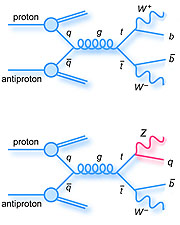 |
| The top figure shows the normal production and decay processes of top quarks. In the bottom figure, the magenta section shows a FCNC process. This type of event is forbidden in the Standard Model and, if it were observed, would require rewriting of the books. |
In an earlier article, I compared the search for something that the Standard Model deems impossible to searching for tiny fairies in the sand on a beach. I also promised that this wouldn’t be the last time you heard about the idea. Today’s result describes another search for the phenomenon using markedly different techniques.
According to the Standard Model, it is exceedingly rare for a quark to change its identity (physicists say flavor) without also changing its charge. In fact, it is so rare that we do not expect to see this happen at the Tevatron. We have a name for this type of process. We call it Flavor Changing Neutral Currents, or FCNC, where the neutral in the title means no change in charge.
Recall that up, charm and top quarks all have the same electrical charge (2/3 that of a proton), while down, strange and bottom quarks all have an electrical charge that is -1/3 that of a proton. When a bottom quark decays, it can only decay into an up or charm quark. Similarly, a top quark could decay into a down, strange or bottom quark, but never an up or charm one.
For other reasons, top quarks decay essentially 100 percent of the time into a W boson and a bottom quark. This provides an ideal situation to search for FCNCs. DZero physicists looked for events in which two top quarks were produced; one of which decayed in the normal way, while the other one underwent FCNC decay and emitted a neutral Z boson and an up or charm quark. As you can see from the figure above, a normal top quark event resulted in two bottom quarks and two W bosons, while a FCNC event resulted in a W boson, a Z boson and two quarks. By selecting specific decay modes of the Z boson, physicists could reliably distinguish these two kinds of events.
The final result of this measurement was that the data is entirely consistent with the Standard Model. No evidence for FCNC was observed and physicists used the data to set the best limit so far achieved. Falling back on our extended, multi-article, metaphor, it’s back to the drawing board until we return with a better sieve.
-- Don Lincoln
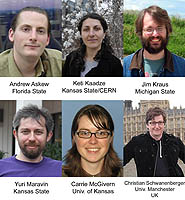 |
These physicists were responsible for this analysis. |
|
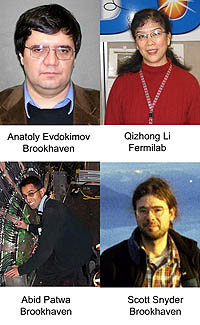 |
| DZero’s forward preshower detector helps identify electrons, which are W&Z boson decay products. These physicists are responsible for making this detector work. |
|
|